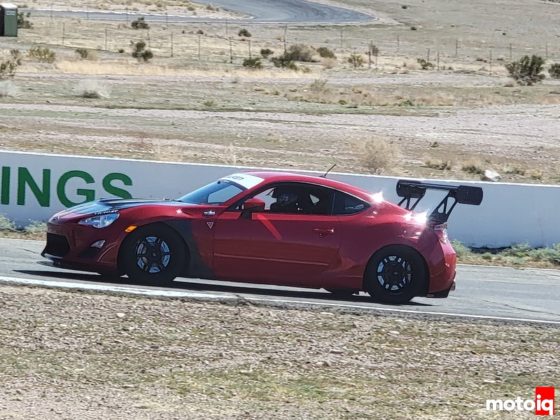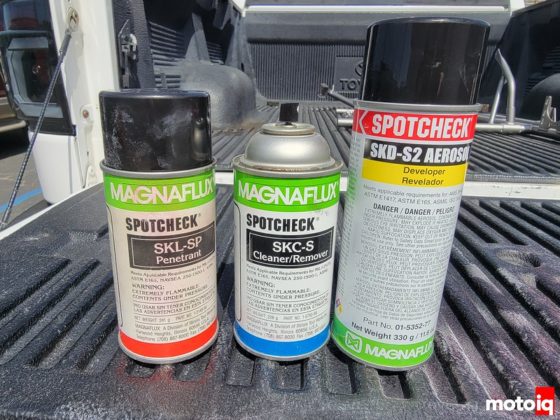 After disconnecting the end links and removing the 4 swaybar bracket bolts, the swaybar easily dropped out of the bottom of the car.
After disconnecting the end links and removing the 4 swaybar bracket bolts, the swaybar easily dropped out of the bottom of the car.
 With the stock swaybar (above) removed, we were able to compare it to the new SuperPro front swaybar (below). The stock swaybar measures at 28.7mm in diameter with a 3.8mm wall thickness (0.15”), while the stiffer SuperPro swaybar is solid and 30mm in diameter. This makes the SuperPro swaybar 68% stiffer than the stock swaybar (268lbs vs 160lbs).
With the stock swaybar (above) removed, we were able to compare it to the new SuperPro front swaybar (below). The stock swaybar measures at 28.7mm in diameter with a 3.8mm wall thickness (0.15”), while the stiffer SuperPro swaybar is solid and 30mm in diameter. This makes the SuperPro swaybar 68% stiffer than the stock swaybar (268lbs vs 160lbs).
RX-7s are incredibly nimble cars with very little polar moment of inertias thanks to its tiny, lightweight, keg-sized rotary engine sitting so low and far back in the engine bay. Because of this, as you put a stickier tire on the front of the car, and as you take weight off the front of the car (which we plan on doing with a battery relocation kit in the near future) front grip will quickly increase and the car’s balance will shift toward oversteer. To counteract this and add stability, rear grip, and restore the balance of the car, stiffer front swaybars are often needed on modified FD RX-7s.
The stiffer, solid 30mm SuperPro swaybar is one of the stiffer options available for the FD RX-7. This is a quality swaybar kit that includes the bar, new endlinks, and new bushings and bushing brackets. We were looking forward to seeing how it improved the balance of the car.
 Removing the passenger side steering rack bushing was quite easy. However, the driver’s side is a different story and it difficult and frustrating.
Removing the passenger side steering rack bushing was quite easy. However, the driver’s side is a different story and it difficult and frustrating.
 The stock steering rack bushing is completely worn out, torn, and shows signs of a lot of friction and movement, which is bad. I would highly recommend replacing the steering rack bushings of all FD RX-7s if they have not been done already.
The stock steering rack bushing is completely worn out, torn, and shows signs of a lot of friction and movement, which is bad. I would highly recommend replacing the steering rack bushings of all FD RX-7s if they have not been done already.
 After wrestling the driver’s side steering rack bushing out of the car, we were able to compare these worn-out bushings to the new, stiffer SuperPro polyurethane bushings. There really is no comparison when you feel how soft and flimsy the old bushings are, which do not retain their shape very well, compared to the polyurethane bushings that are actually softer in durometer than I expected, but are far stiffer than stock and hold their shape much better when handled. This might be characteristics and qualities that give SuperPro their reputation for not increasing NVH, but improving performance.
After wrestling the driver’s side steering rack bushing out of the car, we were able to compare these worn-out bushings to the new, stiffer SuperPro polyurethane bushings. There really is no comparison when you feel how soft and flimsy the old bushings are, which do not retain their shape very well, compared to the polyurethane bushings that are actually softer in durometer than I expected, but are far stiffer than stock and hold their shape much better when handled. This might be characteristics and qualities that give SuperPro their reputation for not increasing NVH, but improving performance.




3 comments
Looking forward to reading more articles as this project continues!
You are developing a responsive and engaging setup, whilst maintaining characteristics to make the car safe and pleasant to drive everyday. As much as I love factory backed GTE/GT3 cars, and wild race/hill climb builds, it is equally enjoyable to see a balanced, practical build like this. As always, fantastic content from everyone at MotoIQ.
Thank you for the feedback!
I am always really surprised by this kind of steering rack designed used on so many cars. It’s basically asking for eventual play because it’s ability to move side to side is not properly constrained. I have only seen a handful of cars that actually properly locate and constrain the rack with bolts directly into the subframe. I know that early 911’s do this while later ones have a similar setup to the RX-7. I am assuming that it’s an NVH issue.
It’s such a huge increase in steering precision and feel to have PU bushings in a steering rack. I think it’s probably one of the cheapest upgrades, and if you have the chance to do it to your vehicle, it’s an absolute must.